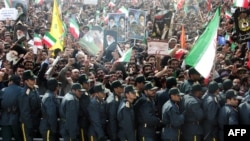For weeks, millions of Iranians and people around the world were waiting with anticipation to see if massive street protests would be repeated in Iran, and whether once again the fragility of the Islamic republic would be proven.
It did not happen. The Tehran regime, knowing that one more popular outburst could irreversibly damage it, began preparing for "D-Day." It brought massive force to the capital, protecting every square and main intersection. It also brought tens of thousands of supporters from small towns -- who were rewarded handsomely to be sure. It shut down text messaging, it slowed down the Internet, and began a wave of arrests and intimidation.
The Green popular protest movement, which has no official leader, could not capitalize on the element of surprise any longer. The regime was ready to use violence and had mobilized its welfare system to bring large numbers to the anniversary ceremonies.
This much was obvious two or three weeks before the February 11 events. It was at this point that the three unofficial leaders of the protest movement came out to call upon the people to "peacefully and quietly" participate in the anniversary gatherings and "voice" their demands.
Many supporters of the Green Movement did just that, but once in the streets or in the ceremonies, they were overwhelmed by the well-organized security forces and regime supporters. The result was that no massive protests took place and one can even argue that their presence in the ceremonies bolstered the claim of the government that their organized events were resoundingly successful.
Obviously, somewhere and somehow, the calculations of Mohammad Khatami, Mehdi Karrubi, and Mir Hossein Musavi, the three leaders, came out to be less than correct. What were they thinking? One possibility is that they did not see any other alternative but to try to challenge the regime by not backing down, hoping that protesters would make enough noise anyway.
Element Of Surprise
But perhaps this was exactly the moment when the movement had to show some sophistication and not fall into the trap set by the regime.
One tactic would have been to wait for the government to mobilize its resources for February 11 and then announce a boycott of the staged ceremonies. The three leaders could have called on their supporters to stay home that day and shout their demands from rooftops, as they have done so effectively since June. In this way they would have had a better chance of demonstrating the power of the movement.
This would have also given a chance to a public, subjected to weeks of intimidation, to have voiced its protest without taking the great personal risk of confrontation in the streets.
One obvious rigidity of the protest movement in Iran is its tight attachment to important days of mourning or celebrations. This gives the regime advance warning to prepare for confrontation and also time to recoup and deal with opponents in between waves of protests. Therefore, the protest movement should be more innovative and flexible to try to choose its own time, place, and method of defiance.
Now, the initiative seems to have passed into the hands of the regime. Of course, in any revolutionary environment nothing is permanent. This was a tactical victory for the regime, but we have not heard the last word from Tehran.
Mardo Soghom is deputy director of broadcast strategy and operations at RFE/RL. The views expressed in this commentary are his own, and do not necessarily reflect those of RFE/RL
It did not happen. The Tehran regime, knowing that one more popular outburst could irreversibly damage it, began preparing for "D-Day." It brought massive force to the capital, protecting every square and main intersection. It also brought tens of thousands of supporters from small towns -- who were rewarded handsomely to be sure. It shut down text messaging, it slowed down the Internet, and began a wave of arrests and intimidation.
The Green popular protest movement, which has no official leader, could not capitalize on the element of surprise any longer. The regime was ready to use violence and had mobilized its welfare system to bring large numbers to the anniversary ceremonies.
This much was obvious two or three weeks before the February 11 events. It was at this point that the three unofficial leaders of the protest movement came out to call upon the people to "peacefully and quietly" participate in the anniversary gatherings and "voice" their demands.
Many supporters of the Green Movement did just that, but once in the streets or in the ceremonies, they were overwhelmed by the well-organized security forces and regime supporters. The result was that no massive protests took place and one can even argue that their presence in the ceremonies bolstered the claim of the government that their organized events were resoundingly successful.
Obviously, somewhere and somehow, the calculations of Mohammad Khatami, Mehdi Karrubi, and Mir Hossein Musavi, the three leaders, came out to be less than correct. What were they thinking? One possibility is that they did not see any other alternative but to try to challenge the regime by not backing down, hoping that protesters would make enough noise anyway.
Element Of Surprise
But perhaps this was exactly the moment when the movement had to show some sophistication and not fall into the trap set by the regime.
One tactic would have been to wait for the government to mobilize its resources for February 11 and then announce a boycott of the staged ceremonies. The three leaders could have called on their supporters to stay home that day and shout their demands from rooftops, as they have done so effectively since June. In this way they would have had a better chance of demonstrating the power of the movement.
This would have also given a chance to a public, subjected to weeks of intimidation, to have voiced its protest without taking the great personal risk of confrontation in the streets.
One obvious rigidity of the protest movement in Iran is its tight attachment to important days of mourning or celebrations. This gives the regime advance warning to prepare for confrontation and also time to recoup and deal with opponents in between waves of protests. Therefore, the protest movement should be more innovative and flexible to try to choose its own time, place, and method of defiance.
Now, the initiative seems to have passed into the hands of the regime. Of course, in any revolutionary environment nothing is permanent. This was a tactical victory for the regime, but we have not heard the last word from Tehran.
Mardo Soghom is deputy director of broadcast strategy and operations at RFE/RL. The views expressed in this commentary are his own, and do not necessarily reflect those of RFE/RL










